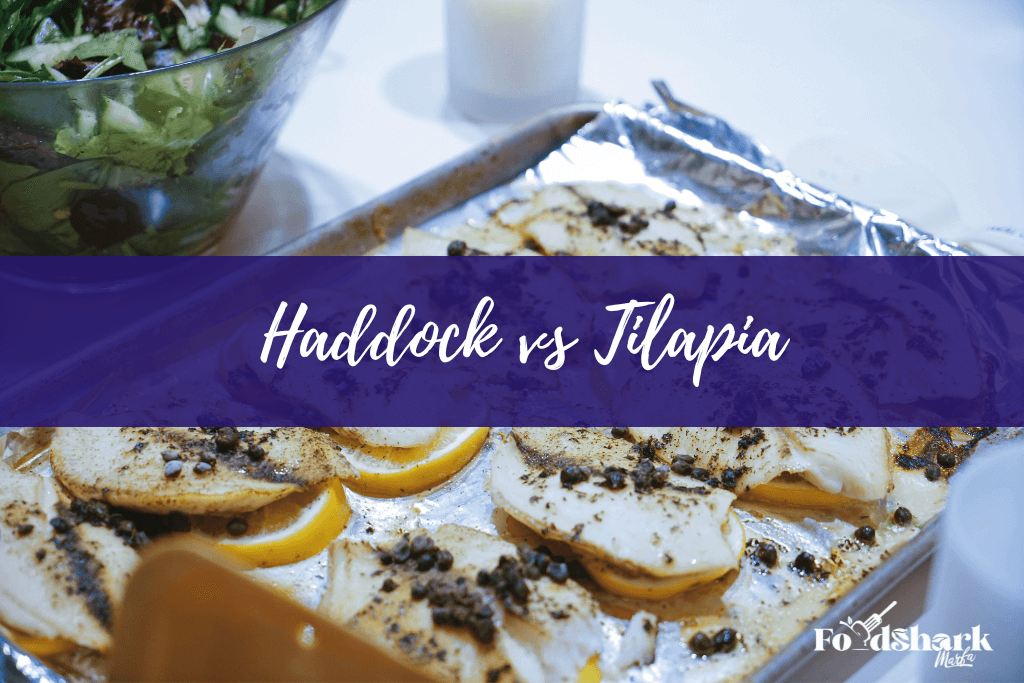Fish is an excellent source of protein, energy, and good fat, so including it in your daily diet has plenty of health benefits. However, there are numerous types of fish available on the market, each of which offers something unique.
As a result, it is critical to contrast and evaluate fishes before including them in your diet. In this regard, both haddock and tilapia have acquired appeal among consumers due to their taste, availability, health benefits, and so on.
Anyhow, both fishes have defining characteristics that set them apart from one another.Enter your text here...
What Is A Haddock Fish?

According to Wikipedia, the haddock, scientifically known as Melanogrammus aeglefinus, is a ray-finned fish that lives in saltwater.
It belongs to the family Gadidae, which is also known as the true cods. Haddock is popular amongst consumers for its mild flavor, solid flesh, and juicy texture.
It is also a demersal fish, meaning they occupy the sea floors and feed at the bottom of the seas or lakes. They occupy the North Atlantic Ocean at depths from 10 to 450 m.
What Is A Tilapia Fish?

On The other hand, the term “Tilapia” refers to approximately a hundred species of cichlid fish, with the most economically important species belonging to the Coptodonini and Oreochromini tribes.
Tilapia are mainly freshwater fish that live in shallow ponds, lakes, and rivers. They are also sometimes found living in brack water.
Tilapia is a very well-loved fish by customers due to its low price and availability. So much so, it is the fourth most popular type of fish, trailing tuna, salmon, and Alaskan pollock, and the third most popular aquaculture or farm-bred seafood product, trailing shrimp and salmon according to research.
Every year since 2006, Americans have devoured more than one pound of tilapia per person.
Haddock Vs Tilapia: Similarities
Because one lives in saltwater and the other lives in freshwater, haddock and tilapia share very few characteristics in common with one another. The flavor and texture of their skins are two of the few characteristics they share in common. Both fishes have a mild flavor and skin that is white and flaky.
In addition, you can use either of these fishes to make food that is delicious and full of flavor. Their subtle flavors are easily disguisable by adding a little bit more spice and seasoning to your dish.
Haddock VS Tilapia: Differences
Haddock and tilapia are fairly different types of fish, each offering various aspects to the plate. They are not only different in price points, but also in size, appearance, natural habitats, nutritional value, etc.
The difference in size
FAO archives show that It is unusual for a haddock to be longer than 80 centimeters and the vast majority of haddocks caught in the United Kingdom are between 30 and 70 centimeters in length.
Due to their varying sizes, haddocks may be separated into as many as six different size categories at the port market before being put up for sale. For instance, in Aberdeen, the rough categories are more than 76 cm; 64-76 cm; 54-63 cm; 44-53 cm; 36-43 cm; 27-35 cm.
Compared to haddocks, tilapia are much smaller in size, though their size can vary from species to species. The common length for the blue tilapia (Oreochromis aureus) is 16 centimeters. Tilapia can weigh up to 11 pounds.
The difference in appearance
In terms of appearance, the haddock's body shape is elongated and tapering, as is typical of members of the cod family.
It has a small mouth and a wedge-shaped snout because the lower profile of the face is straight and the upper profile is slightly rounded. Haddocks are distinguished by a dark, continuous lateral line, three dorsal fins and two anal fins, and a dark spot beneath the first dorsal fins.
In contrast, tilapia have deep, laterally compressed bodies. Their mouths protrude, usually surrounded by wide, often swollen lips.
Their identifying features include a long dorsal fin and a lateral line that often breaks near the end of the dorsal fin and begins again two or three scale rows below.

The difference in natural habitats
As mentioned before, haddocks are demersal saltwater fish. Even though they are found on both sides of the North Atlantic, they are mostly populated on the bottom of the Eastern Atlantic.
Tilapia is mostly a freshwater fish. They live and reproduce in shallow ponds, streams, rivers, etc. Tilapia is one of the most farmed fish in the world.
Hybrid tilapias almost exclusively reside in farms under controlled environments. In 2002, the global production of farmed tilapia was approximately 1.5 million tonnes.
The difference in price point
Haddock is a demersal fish, which means it is more difficult to fish for and more expensive to supply to the market.
On the other hand, tilapia is a fish that lives in freshwater environments and is less difficult to catch and sell at retail outlets. In addition to this, they are produced on an industrial scale in aquaculture facilities located all over the world.
The fast growth rate of tilapia combined with their plant-based diet makes tilapia farming extremely profitable. As a result, the cost of tilapia is significantly lower than that of haddock.
The difference in nutritional value
As for the nutritional value of the two fishes, if we compare the same sources, 100 grams of cooked haddocks contain 90 kcal of energy, 20 grams of protein, and 0.55 grams of total lipid.
On the other hand, 100 grams of cooked tilapia contain 128 kcal of energy, 26.2 grams of protein, and 2.65 grams of total fat. As we can see from the comparison, tilapia have more nutritional perks than haddocks.
Between The Two, Which One Should You Choose?
When pricing and nutritional benefits are considered, tilapia is the clear winner. However, the majority of tilapia found in marketplaces are farmed rather than wild.
It is not always feasible to check the quality of the fish because farmers frequently feed the fish hazardous food in order for them to grow faster. In such cases, haddocks can be a safer choice.

Again, if the price point is not an issue for you, you can easily go for haddocks as they will add the flavors of seafood to your dish. On another note, haddocks contain more sodium than tilapia. If you are someone with kidney issues, you can choose to switch to tilapia instead.
No matter which fish you choose though, you can always benefit from getting a grill basket to grill your favorite fish with!

Conclusion
In conclusion, both haddock and tilapia are unique in their own way. In most cases, tilapia is the preferred option over haddocks.
However, it all boils down to individual choice. You can even switch out one for the other in your regular diet in order to add a variety of tastes and flavors to your breakfast, lunch, and dinner!


